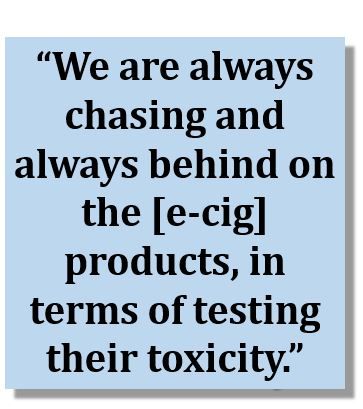- Clinical Technology
- Adult Immunization
- Hepatology
- Pediatric Immunization
- Screening
- Psychiatry
- Allergy
- Women's Health
- Cardiology
- Pediatrics
- Dermatology
- Endocrinology
- Pain Management
- Gastroenterology
- Infectious Disease
- Obesity Medicine
- Rheumatology
- Nephrology
- Neurology
- Pulmonology
E-Cigarettes: The New Addiction and Why Physicians Must be Concerned
DALLAS-At the American Thoracic Society meeting thought leaders cited disturbing trends in e-cigarette use by teens and warned of health dangers, known and unknown.

DALLAS-In a session titled “Addicting a New Generation: Juuling, Vaping, Heat Not Burn, Flavorings, and the Evidence for Why We Should Be Very Concerned,” at the American Thoracic Society Meeting 2019 held May 17 – 22, 2019, in Dallas, Texas, experts described the alarming growth in the rate of e-cigarette use among teens and emerging data on the safety of the new electronic nicotine delivery systems.
According to the National Youth Tobacco Survey, 1 in 5 high school students were e-cigarette users in 2018, up from approximately 1 in 100 in 2011. Currently, more than 1 in 4 high school students use any tobacco or nicotine product. “Up until 2010, we had been conquering the tobacco epidemic. Tobacco use among youth in our population had been going down,” said Harold J. Farber, MD, MSPH, ATSF, Texas Children’s Hospital, Houston, Texas. “Now we’re starting to see this rise again.”
Contrary to common belief, the use of e-cigarettes is not necessarily associated with quitting or avoiding smoking tobacco, and may have the opposite effect. A systematic review and meta-analysis among adolescents and young adults found that e-cigarette users had a more than three times greater risk of starting cigarette smoking than those who had never used e-cigarettes.
Small, discrete, amazingly addictive
Small, discrete, amazingly addictive. There are dozens of e-cigarette brands on the market, but one causing particular alarm is the JUUL, which entered the market in 2015 and by November of 2018 had secured 76% of the e-cigarette market. “[JUUL is] very small, very discrete, and amazingly addictive,” said Dr. Farber. JUUL uses a patented nicotine salt-nicotine benzoate-that increases the rate of nicotine uptake and has less adverse effects than freebase nicotine, often found in traditional tobacco cigarettes. “You find kids saying it gives them a better buzz,” he said.
The US Food and Drug Administration gained the authority to regulate e-cigarettes in 2016, but data about safety of the products is needed in order to decide how best to regulate them. A primary problem, however, is that these products have only been on the market for a few years and the market is constantly changing, explained Ilona Jaspers, PhD, University of North Carolina at Chapel Hill. “We are always chasing and always behind on the products, in terms of testing their toxicity,” she said.
Not just plain vanilla. A feature of e-cigarettes that especially worries Dr. Jaspers when it comes to safety is the flavorings used; while the natural flavors are recognized as safe when used as a food product, that safety cannot be assumed when the route of exposure is changed to inhalation. Of particular concern are the aromatic aldehyde compounds, which include the cinnamon flavor (cinnamaldehyde), almond flavor (benzaldehyde), and vanilla flavor (vanillin and ethyl vanillin). Other aromatic aldehydes, such as formaldehyde, are known to be toxic when inhaled, and cinnamaldehyde has been shown to inhibit the function of immune cells, including macrophages, neutrophils, and natural killer cells. “Why do we think that [these flavors] actually could be safe when we inhale them?” she asked rhetorically.
More research on human response
More research on human response. Studies also have shown that e-cigarettes appear to have different effects on the body than conventional cigarettes. For instance, a mid-2018 study showed that airways among e-cigarette users were inflamed whereas the airways of cigarette smokers and nonsmokers were not. Another study found e-cigarette users to have more gene expression changes than combustible cigarette smokers and to have an overall immune suppressive phenotype. A poster reported at the American Thoracic Society meeting went a step further and showed a reduced antiviral response within the respiratory tract among e-cigarette users compared with non-users.
Although there is no conclusive evidence to date, Dr. Jaspers speculated that it is possible new diseases may emerge among e-cigarette users. For example, a 2018 case report in the journal Pediatrics described an 18-year-old female who developed hypersensitivity pneumonitis and acute respiratory distress syndrome after e-cigarette use.
“We may not be seeing [chronic obstructive pulmonary disease], but we may be seeing an uptick in new diseases and new clinical phenotypes,” she said.
